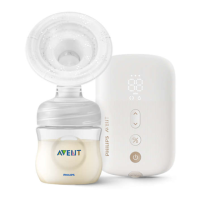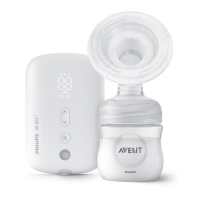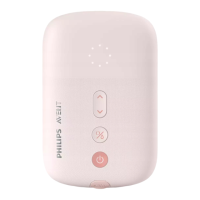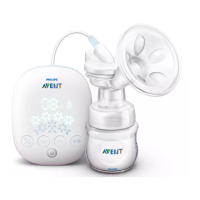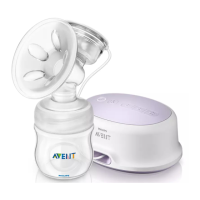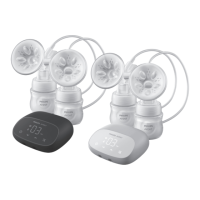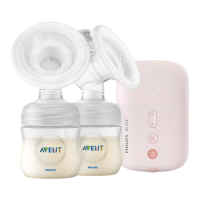Troubleshooting
This chapter summarizes the most common problems you could encounter with the breast pump. If you are unable to solve
the problem with the information below, visit www.philips.com/support for a list of frequently asked questions or contact the
Consumer Care Center in your country.
Problem Solution
I experience pain when
I use the breast pump.
- Choose a suction level that is comfortable for you.
- Check if the silicone diaphragm is not damaged (does not have small cracks, holes etc.).
- Make sure that your nipple is placed in the center of the cushion.
- If the pain persists, stop using the breast pump and consult your healthcare professional.
The breast pump does
not switch on (indicator
lights do not go on).
- Only use the adapter supplied.
- Check if you are using the adapter that was supplied with the device and that the adapter is
connected correctly to the motor unit and wall socket.
- Connect the adapter to another wall socket and check if the breast pump can be switched on.
- If the problem persists, contact the Consumer Care Center via www.philips.com/support.
All indicator lights
on the motor unit are
ashing and device
shuts o automatically.
- Try to switch on the motor unit again.
- Check if you are using the adapter that was supplied with the device.
- If the problem persists, contact the Consumer Care Center via www.philips.com/support.
I do not feel any
suction/the suction
level is too low.
- If possible, try a higher suction level.
- Check if the silicone diaphragm is assembled correctly (see 'Assembling the breast pump').
- Check if the white valve is not damaged and is assembled correctly (see 'Assembling the breast pump').
- Check if the other parts of breast pump are intact and assembled correctly (see 'Assembling the breast pump').
- Make sure that the pump is positioned correctly on the breast to allow a seal between breast pump and breast.
- If you still do not feel any suction, please contact the Consumer Care Center via
www.philips.com/support.
The suction of the
breast pump is too
strong.
- If possible, try a lower suction level. When you express for the rst time, start with the default suction
level (level 5 in stimulation mode, level 11 in expression mode) and increase/decrease the level when
needed. During dierent expression sessions, dierent levels may feel most comfortable for you.
- Make sure that you only use the breast pump parts provided with this breast pump.
- Check if the silicone diaphragm is not damaged (does not have small cracks, holes etc.).
- If the problem persists, contact the Consumer Care Center via www.philips.com/support.
I express little/no milk
when I use my breast
pump.
- If you do not feel enough suction, please check Troubleshooting item 'I do not feel any suction/the
suction level is too low'.
- If you are using the Philips Avent breast pump for the rst time, you may need some practice before
you are able to express any milk. More expressing tips can be found on the Philips Avent website
www.philips.com/avent.
The breast pump is
cracked/discolored.
- Make sure that the breast pump does not come into contact with antibacterial or abrasive
detergents/cleaners. Combinations of detergents, cleaning products, sterilization solution, softened
water and temperature uctuations may cause the plastic to crack. If any crack is found, stop
using the breast pump immediately. Contact the Philips Avent Consumer Care Center for spare
components.
- Food colorings can discolor components, but this does not aect usage of these components.
- Keep all components away from sources of heat or direct sunlight as they can discolor components.
The silicone tube is
too loose when it is
plugged into the motor
unit or cap.
Replace the silicone tube connector. Contact the Consumer Care Center via
www.philips.com/support for spare components.
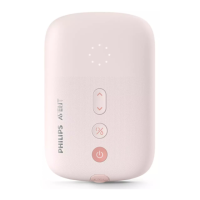
